
Cecropia is a Neotropical genus consisting of 61 recognized species with a highly distinctive lineage of dioecious trees. The genus consists of pioneer trees in the more or less humid parts of the Neotropics, with the majority of the species being myrmecophytic. Berg and Rosselli state that the genus is characterized by some unusual traits: spathes fully enclosing the flower-bearing parts of the inflorescences until anthesis, patches of dense indumentums (trichilia) producing Mullerian (food) at the base of the petiole, and anthers becoming detached at anthesis. Cecropia is most studied for its ecological role and association with ants. Its classification is controversial; in the past, it has been placed in the Cecropiaceae, Moraceae, or Urticaceae. The modern Angiosperm Phylogeny Group system places the "cecropiacean" group in the Urticaceae.
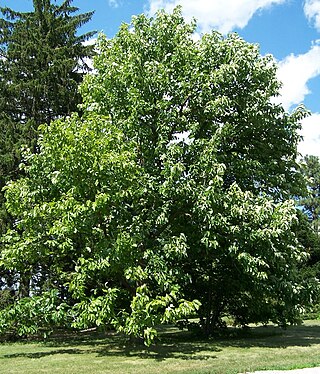
Magnolia acuminata, commonly called the cucumber tree, cucumber magnolia or blue magnolia, is one of the largest magnolias, and one of the cold-hardiest. It is a large forest tree of the Eastern United States and Southern Ontario in Canada. It is a tree that tends to occur singly as scattered specimens, rather than in groves.

Dacrycarpus dacrydioides, commonly known as kahikatea and white pine, is a coniferous tree endemic to New Zealand. A podocarp, it is New Zealand's tallest tree, gaining heights of 60 m over a life span of 600 years. It was first described botanically by the French botanist Achille Richard in 1832 as Podocarpusdacrydioides, and was given its current binomial name Dacrycarpus dacrydioides in 1969 by the American botanist David de Laubenfels. Analysis of DNA has confirmed its evolutionary relationship with other species in the genera Dacrycarpus and Dacrydium.

Pandanus tectorius is a species of Pandanus (screwpine) that is native to Malesia, Papuasia, eastern Australia, and the Pacific Islands. It grows in the coastal lowlands typically near the edge of the ocean. Common names in English include thatch screwpine, Tahitian screwpine, hala tree and pandanus. The fruit is edible and sometimes known as hala fruit.

Cryptocarya is a genus of evergreen trees belonging to the laurel family, Lauraceae. The genus includes more than 350 species, distributed through the Neotropical, Afrotropical, Indomalayan, and Australasian realms.
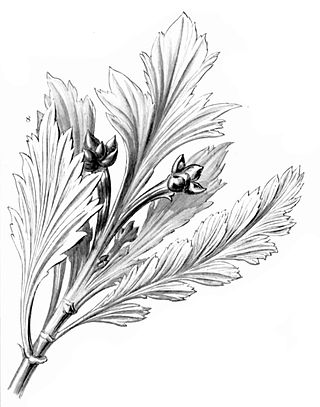
Phyllocladus aspleniifolius, commonly known as the celerytop pine, is an endemic gymnosperm of Tasmania, Australia. It is widespread and common in Tasmania, with the most abundance in the western highlands. Its ‘leaves’ appear similar to those of a celery plant, hence the common name.

Allocasuarina torulosa, commonly known as forest oak, rose sheoak, river oak or Baker's oak, is a species of flowering plant in the family Casuarinaceae and is endemic to eastern Australia. It is a slender, usually dioecious tree that has drooping branchlets up to 140 mm (5.5 in) long, the leaves reduced to scales in whorls of four or five, and the fruiting cones 15–33 mm (0.59–1.30 in) long containing winged seeds 7–10 mm (0.28–0.39 in) long.
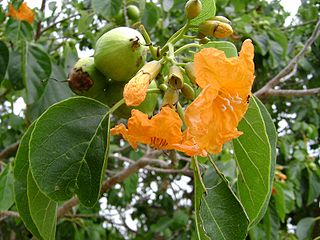
Cordia subcordata is a species of flowering tree in the borage family, it can be found growing in eastern Africa, South Asia, Southeast Asia, northern Australia and the Pacific Islands including Hawaii. The plant is known by a variety of names including kou, beach cordia, sea trumpet, and kerosene wood, among others.

The black wood pigeon or Japanese wood pigeon is a species of bird in the family Columbidae. It is found in East Asia along shorelines of the Pacific's Korea Strait, Philippine Sea and East China Sea. It is believed to be the largest representative of the genus, Columba, and has a weight of around 550 grams (1.2 lb) and an overall length of 43 cm (17 in). Its natural habitats are temperate forests and subtropical or tropical moist lowland forests. The species is in decline owing to habitat loss, habitat degradation, deforestation and hunting. This wood pigeon is endemic to the laurel forest habitat.
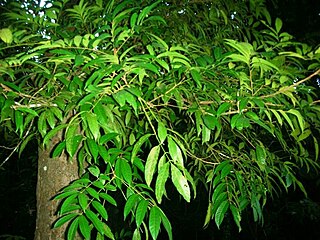
Aglaia spectabilis is a species of tree in the family Meliaceae, found from the Santa Cruz Islands in the southwest Pacific to Queensland (Australia), Southeast Asia, Yunnan (Zhōngguó/China) and the Indian subcontinent. It grows from a 1m shrub to an emergent 40m tall tree, depending on the habitat. Its wood is commercially exploited as timber, but otherwise is of poor quality with limited use. The fruit are eaten, and used in folk medicine. The seeds are large in comparison to other plants, and a major source of dispersal of the species are hornbills eating the fruit, flying away from the tree and regurgitating the seeds.It is also found in Assam, India

Ficus obliqua, commonly known as the small-leaved fig, is a tree in the family Moraceae, native to eastern Australia, New Guinea, eastern Indonesia to Sulawesi and islands in the southwestern Pacific Ocean. Previously known for many years as Ficus eugenioides, it is a banyan of the genus Ficus, which contains around 750 species worldwide in warm climates, including the edible fig. Beginning life as a seedling, which grows on other plants (epiphyte) or on rocks (lithophyte), F. obliqua can grow to 60 m (200 ft) high and nearly as wide with a pale grey buttressed trunk, and glossy green leaves.
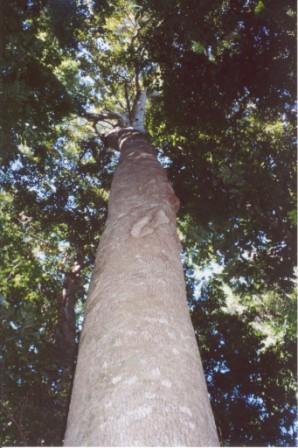
Gmelina leichhardtii, the white beech, is a tree of eastern Australia. Scattered individuals or small groups of trees naturally occur from the Illawarra district of New South Wales to near Proserpine in tropical Queensland. The white beech or grey teak is a fast-growing tree, growing on volcanic and alluvial soils in areas of moderate to high rainfall. It also grows on poorer sedimentary soils in fire free areas. White beech may occasionally be seen in Australian rainforests, though their status is considered "uncommon". Unlike the Australian red cedar, the white beech has not recovered particularly well after logging in the 19th and 20th centuries.

Celtis paniculata, commonly known as tripewood, silky keltis, silky celtis, native hackberry, native celtis, Investigator tree or whitewood, is a rainforest tree native to parts of Malesia, Melanesia and Australia.

Decalobanthus peltatus is a species of flowering vine in the morning glory family, Convolvulaceae, that is native to Pemba Island, the Mascarene Islands, Madagascar, the Seychelles, Indonesia, Malaysia, the Philippines, northern Queensland (Australia) and French Polynesia. It has been introduced and subsequently become invasive on some of the other Pacific islands, such as New Caledonia, Samoa, Fiji, Solomon Islands, and Palau.

Diploglottis australis, known as the native tamarind, is a well known rainforest tree of eastern Australia. It is easily identified by the large sausage shaped leaflets.
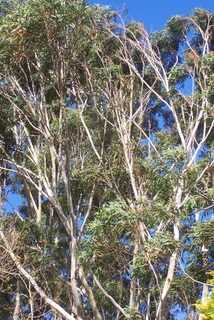
Eucalyptus pilularis, commonly known as blackbutt, is a species of medium-sized to tall tree that is endemic to eastern Australia. It has rough, finely fibrous greyish bark on the lower half of the trunk, smooth white, grey or cream-coloured bark above, lance-shaped to curved adult leaves, flower buds in groups of between seven and fifteen, white flowers and hemispherical or shortened spherical fruit.

Celtis africana, the white stinkwood, is a deciduous tree in the family Cannabaceae. Its habit ranges from a tall tree in forest to a medium-sized tree in bushveld and open country, and a shrub on rocky soil. It occurs in Yemen and over large parts of Africa south of the Sahara. It is a common tree in the south and east of southern Africa, where the odour given off by freshly-cut green timber is similar to that of Ocotea bullata or black stinkwood.

Drypetes deplanchei is a tree of eastern and northern Australia. It also occurs in New Caledonia and Lord Howe Island. The genus is derived from the Greek, dryppa meaning "olive fruit". The species named after Dr. Emile Deplanche, who collected this plant at New Caledonia. Common names include yellow tulip, grey boxwood, white myrtle, grey bark and yellow tulipwood.

The Samoan tropical moist forests are a tropical moist broadleaf forest ecoregion in the Samoan Islands of the Pacific Ocean.

Inocarpus fagifer, commonly known as the Tahitian chestnut or Polynesian chestnut, is a species of flowering plant in the subfamily Faboideae of the legume family, Fabaceae. The tree has a wide range in the tropics of the south-west Pacific and south-east Asian regions, and a history of traditional use by the peoples of Polynesia and Melanesia. It is the only edible and culturally important member of the genus Inocarpus.



















